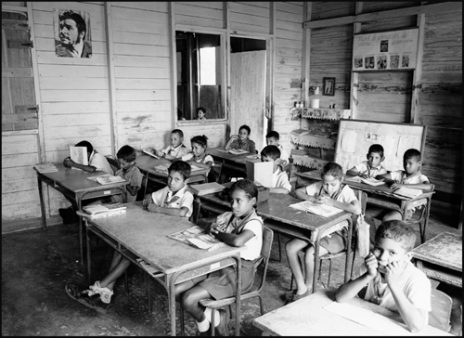Applying Findings from Neuroscience to Education in Practice and Educational Policy-Making
10 September 2018
In this blog post, the last post of my post series, I intend to outline, by means of concrete examples, how findings from neuroscience can contribute practically to the improvement of education. As a prior teacher in moral education in Korean secondary schools, I was interested in how to effectively promote students’ motivation to engage in prosocial behavior, such as voluntary service activity, through classroom activities.
Given that many sections of moral education textbooks featured stories of moral exemplars, morally great people, to elevate and inspire students and let them emulate presented exemplary behavior, I decided to examine how to improve the effectiveness of the aforementioned exemplar-applied educational method. In fact, unfortunately, when I introduced such stories, especially historic moral figures, such as Mother Teresa and Martin Luther King Jr., in my classes, students did not seem to be strongly elevated or motivated. So, I planned to work on an educational intervention study in a classroom setting to find a way to address this issue associated with the utilization of moral exemplars in moral education.
I designed my classroom intervention to effectively promote motivation to engage in voluntary service activities based on what I had found from my neuroimaging studies. As I reviewed in my previous blog post, I meta-analyzed previous fMRI studies of moral functioning and conducted an fMRI experiment examining the interaction between self-related and morality-related brain regions. Findings demonstrated that self-related psychological processes are closely involved in moral functioning in general. Given these findings, I hypothesized that the perceived closeness of presented exemplars from students’ perspectives, in other words, the perceived connectivity between the exemplars and the students’ selfhood, would influence the motivational impact of the exemplars. Following a previous social psychological study examining the effectiveness of different types of non-moral exemplars, I examined whether attainable and relevant exemplars, such as peers, friends, and family members, more effectively motivated students to engage in voluntary service activities when compared with unattainable and irrelevant models, such as historic figures that had been frequently presented in textbooks. Students were presented with different types of exemplars for eight weeks, and their service engagement was measured before and after the intervention period. As I hypothesized, students assigned to the peer exemplar group showed significantly greater improvement in service engagement compared with their counterparts assigned to the historic figure group. This result was consistent with what I found in my neuroimaging study, that selfhood matters in moral functioning. It may suggest that moral educators and school teachers consider introducing moral exemplars who are close to the students to effectively promote their moral motivation, since these exemplars are likely to be perceived as attainable and relevant.
Some educators and educational policy-makers may also be interested in how neuroscience can inform the improvement of education in practice at the macroscopic level. Educational interventions can influence students’ developmental trajectories for the long-term. Thus, even if small-scale interventions, such as the aforementioned classroom intervention, are found to produce positive outcomes, scaling up such intervention programs should be done very carefully. Of course, the best way to address this question is to conduct multiple long-term, large-scale experiments at the district level or even the national level, to examine whether the developed interventions effectively work in diverse environments. However, doing so might not be realistic in many cases due to the limitations in time, money and resources, and potential ethical issues. To deal with these limitations, computer simulation based on data collected from relatively small-scale studies can be informative. My computer simulation articles introduced how to estimate long-term effects of different types of educational interventions using the data collected from my classroom experiment. My computer simulation model was developed to examine what type of intervention can produce the best outcome and how often the intervention should be conducted to produce meaningful effects over the long term. Thanks to the rapid development of computer science, now it is possible to make a more precise simulation model based on deep learning, which is originally inspired by neuroscience. Compared with the traditional model, the accuracy of the deep learning-applied model is greater than 6% when predicting the outcomes of educational interventions. Given these considerations, methodologies in computer science and neuroscience can help us better simulate outcomes of educational interventions based on small datasets before the actual application of developed interventions in wider settings. Such methodological advances will be able to assist educational policy making processes.
So far, I discussed how we, educators, can learn from neuroscience to improve education in practice. My blog post series started with an overview of neuroscience and education, I then offered an introduction to how to identify using neuroscientific evidence the core psychological processes associated with learning. Finally I have now discussed the application of neuroscience to education in practice and to educational policy making. Although the studies introduced in the series are somehow preliminary, the methodologies used in the studies might inform researchers and educators who want to apply findings in neuroscience to education.
Image: Cuban schoolchildren in a classroom in the province of Guantánamo. Photo by Mikhail Evstafiev, Source Wikipedia
- October 2025
- September 2025
- August 2025
- July 2025
- June 2025
- May 2025
- April 2025
- March 2025
- February 2025
- January 2025
- December 2024
- November 2024
- October 2024
- September 2024
- August 2024
- July 2024
- June 2024
- May 2024
- April 2024
- March 2024
- February 2024
- January 2024
- December 2023
- November 2023
- October 2023
- September 2023
- August 2023
- July 2023
- June 2023
- May 2023
- April 2023
- March 2023
- February 2023
- January 2023
- December 2022
- November 2022
- October 2022
- September 2022
- August 2022
- July 2022
- June 2022
- May 2022
- April 2022
- March 2022
- February 2022
- January 2022
- December 2021
- November 2021
- October 2021
- September 2021
- August 2021
- July 2021
- June 2021
- May 2021
- April 2021
- March 2021
- February 2021
- January 2021
- December 2020
- November 2020
- October 2020
- September 2020
- August 2020
- July 2020
- June 2020
- May 2020
- April 2020
- March 2020
- February 2020
- January 2020
- December 2019
- November 2019
- October 2019
- September 2019
- August 2019
- July 2019
- June 2019
- May 2019
- April 2019
- March 2019
- February 2019
- January 2019
- December 2018
- November 2018
- October 2018
- September 2018
- August 2018
- July 2018
- June 2018
- May 2018
- April 2018
- March 2018
- February 2018
- January 2018
- December 2017
- November 2017
- October 2017
- September 2017
- August 2017
- July 2017
- June 2017
- May 2017

